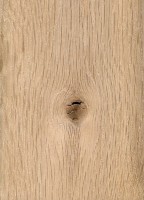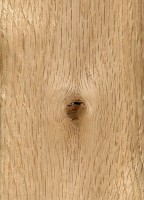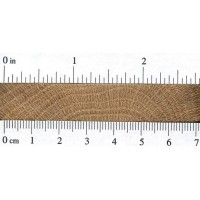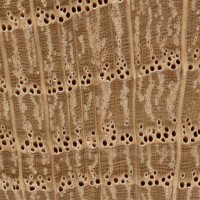 |
Common Name(s): Pin Oak
Scientific Name: Quercus palustris Distribution: Eastern United States Tree Size: 50-75 ft (15-23 m) tall, 2-4 ft (.6-1.2 m) trunk diameter Average Dried Weight: 44 lbs/ft3 (705 kg/m3) Specific Gravity (Basic, 12% MC): .58, .71 Janka Hardness: 1,500 lbf (6,650 N) Modulus of Rupture: 13,860 lbf/in2 (95.6 MPa) Elastic Modulus: 1,713,000 lbf/in2 (11.81 GPa) Crushing Strength: 6,750 lbf/in2 (46.6 MPa) Shrinkage:Radial: 4.3%, Tangential: 9.5%, Volumetric: 14.5%, T/R Ratio: 2.2 |
Color/Appearance: Has a light to medium reddish-brown color, though there can be a fair amount of variation in color. Conversely, White Oak tends to be slightly more olive-colored, but is by no means a reliable method of determining the type of oak.
Grain/Texture: Has medium-to-large pores and a fairly coarse grain.
Endgrain: Ring-porous; 2-4 rows of large, exclusively solitary earlywood pores, numerous small latewood pores in radial arrangement; tyloses absent; growth rings distinct; rays large and visible without lens; apotracheal parenchyma diffuse-in-aggregates (short lines between rays).
Rot Resistance: Red oaks such as Pin Oak do not have the level of decay and rot resistance that White Oaks possess. Durability should be considered minimal.
Workability: Easy to glue, and takes stain and finishes very well.
Odor: Has a tell-tale smell that is common to most oaks. Most find it appealing.
Allergies/Toxicity: Although severe reactions are quite uncommon, oak has been reported as a sensitizer. Usually most common reactions simply include eye and skin irritation, as well as asthma-like symptoms. See the articles Wood Allergies and Toxicity and Wood Dust Safety for more information.
Pricing/Availability: Slightly less expensive than White Oak, Red Oak is in good/sustainable supply and is moderately priced. Thicker 8/4 planks, or quartersawn boards are slightly more expensive per board foot.
Sustainability: This wood species is not listed in the CITES Appendices or on the IUCN Red List of Threatened Species.
Common Uses: Cabinetry, furniture, interior trim, flooring, and veneer.
Comments: Pin Oak falls into the red oak group, and shares many of the same traits as Red Oak (Quercus rubra). Red Oak, along with its brother White Oak, are commonly used domestic lumber species. Hard, strong, and moderately priced, Red Oak presents an exceptional value to woodworkers—which explains why it is so widely used in cabinet and furniture making.
- Black Oak (Quercus velutina)
- Bog Oak
- Brown Oak
- Bur Oak (Quercus macrocarpa)
- California Black Oak (Quercus kelloggii)
- Cherrybark Oak (Quercus pagoda)
- Chestnut Oak (Quercus prinus)
- English Oak (Quercus robur)
- Holm Oak (Quercus ilex)
- Japanese Oak (Quercus mongolica)
- Laurel Oak (Quercus laurifolia)
- Live Oak (Quercus virginiana)
- Oregon White Oak (Quercus garryana)
- Overcup Oak (Quercus lyrata)
- Post Oak (Quercus stellata)
- Red Oak (Quercus rubra)
- Scarlet Oak (Quercus coccinea)
- Sessile Oak (Quercus petraea)
- Shumard Oak (Quercus shumardii)
- Southern Red Oak (Quercus falcata)
- Swamp Chestnut Oak (Quercus michauxii)
- Swamp White Oak (Quercus bicolor)
- Turkey Oak (Quercus cerris)
- Water Oak (Quercus nigra)
- White Oak (Quercus alba)
- Willow Oak (Quercus phellos)
 |
 |
 |
 |





I have Three Pin Oaks that are about 60 ft in height and about 2-3 ft in diameter how old would these Trees be?
Was the puppet Pinocchio made from wood of pin oak tree? Large oak in Italy dedicated to his story but not listed as a pin oak.
We have a pin oak tree at the golf course I work at that is only about 50 ft tall but the trunk diameter is over 6 ft (that is not an exaggeration). It is a massive tree and it must have been there for a really really long time. I’m not sure how old a pin oak tree would be if it was 6 ft in diameter. It is longer than a golf cart! My guess is that the tree was remained undisturbed for the longest of time, probably well before the United States even became a country. It… Read more »
Just cut 2 pin oaks this week. Each are 4′ in diameter to 3′ in diameter for 25′ Base is 6′ and what you need to know is the rings of a pin oak are larger than other trees. These 2 trees are about 75 years old. My guess is the pin oak on your golf course, receiving the benefit of regular water and fertilizer is no more than 150 years old taking you back to the Civil War at best.
Just dropped a 36” pin oak that was 51 years old. It was pretty much in the open. Some growth rings were 1/2”. Grows fast.
I agree that the pin oak falls into the red oak category, but it should really be in a category by itself when it comes to uses. Pin Oak is “stringy” (for lack of a better term), therefor it is not sought out for its lumber like a cherry bark would be. It is actually a very common pallet wood where I come from as most do not like to use its lumber for woodworking/furniture applications. And while trees (like people) tend to be different from one to the next, I find most pin oaks to have a stale, urine… Read more »
Being the Oak species most likely to be planted by people, the wood should be used more.
My wife’s parents are going to remove a pin oak tree from their front yard. it is over 50 feet in height and about 40 years old. would this tree be worth them trying to do more than simply have it cut down and hauled off? I believe it will be expensive to have removed and wondering if there is sufficient value to make it economically beneficial versus a large expense. They live outside Memphis Tn.
If you are a wood worker then cut the tree down to workable lengths and lumber it yourself. There are a ton of things you can build with that wood.
my pin oak trees, (2,age=about 40 yrs) are light brown with a very dark brown, almost black heartwood.
I’ll send a picture next time I cut some :)